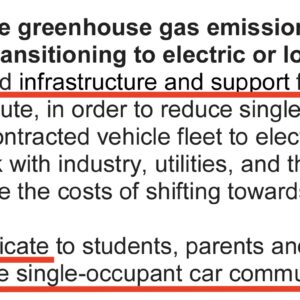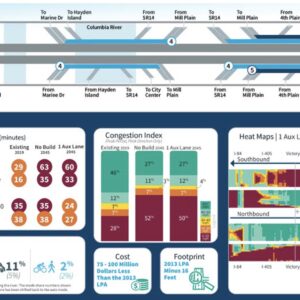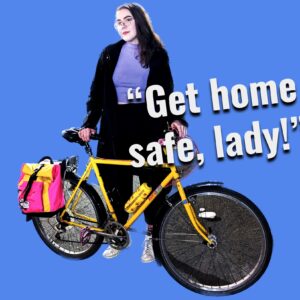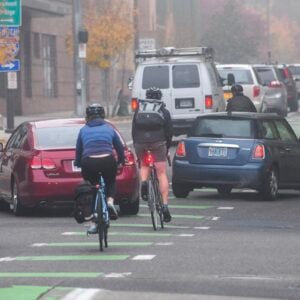— The author of this post has requested to be anonymous.
Last night while yet another person walking in Portland was killed by a person driving, the Oregon governor accomplished a personal priority, spending part of $20 million “to clear graffiti and litter along a beleaguered five-mile stretch of I-84” during an eight hour closure. Even if you also prefer the aesthetics of gray concrete underpasses, there’s an interesting twist: I-84 isn’t beleaguered by unsanctioned community murals, government neglect, or urban campers — it’s beleaguered by cars.
To experience this monumental transportation infrastructure without the normalized deadly threat of motor vehicles, I set out last night at the midnight closure, with a couple dozen intrepid explorers to ride I-84 by bicycle. Based on media reports of the civic emergency that necessitated this special intervention, I prepared mentally for what we might encounter.
The ride description said “Prepare for side streets, dirt paths, gravel and smooth pavement. Prepare to lift your bike and the bikes of others over things–if it comes to that. Prepare to go in the out way, and out the in way,” but my imagination embellished that further.
Compared to every bikeway I’ve ever been on, and most surface streets, I-84 was as clean as a whistle, and smooth as butter, before the cleanup even got started.
I imagined graffiti abatement armies feverishly spraying paint over every surface of this dirty stricken corridor, a dangerous work zone motorway strewn with barriers, disoriented evicted campers, and slick with gallons of fresh ‘ODOT Gray.’ I pictured crews marching oblivious across the highway hoisting sharp-edged replacement signage like slapstick comedy setups on a heavily-traveled cratered moonscape of ruts and potholes. I think I was expecting these things because they are like what I often experience on the bikeways of Portland, a maze of obstacles, glass-strewn and overgrown, where riders must be ever-vigilant to arrive safely at their destination.
After a planning session over a hand-drawn map to determine the best access point, a steep embankment traverse, some off-camber singletrack over hobo trails, and a stealthy recon, a collective decision was made to “send it.” We lifted our bikes over the concrete barrier wall and pedaled west between the truck mounted attenuators and toward the river and the unknown. As we picked up speed under the half moon, and spread our wings across the generous and empty three-lane roadway, I experienced something new and surprising. We were freely gliding through the city — without any fear.
As a bicycle rider, you rarely get to have this experience. Bikeways in the US are designed to slow riders down, with chicanes, push-buttons, and ever-new safety interventions. Even separated bike paths are interrupted by debris, engineered obstacles, and increasingly by cars.
But I-84, the T.H. Banfield Expressway, is designed for going fast, and so we did. We quickly maxed out our gearing on the flat straightaways and banked turns, with the fixed-gear riders furiously spinning to keep up. Some turned off their lights to make our presence less pronounced, and because there were no defects to spot on the well-lit pavement.
Compared to every bikeway I’ve ever been on, and most surface streets, I-84 was as clean as a whistle, and smooth as butter, before the cleanup even got started. Were there colorful murals on the underpasses? I wouldn’t have noticed. We were busy enjoying the cool unpolluted night air, and the glorious quietude. There’s something about gliding through the city at high speed — in silence — that makes bicycling feel even more like you are flying.
Here’s something you can’t usually do while you are driving down a highway: have a conversation with other travelers. We talked about the exhilaration and the joy we were feeling, and how to experience it more often. “This is what we could have,” I said, thinking about Dutch bicycle highways. “This is what we already have,” was the reply.
Just like on our surface streets, it’s the cars that ruin our highways. Instead of spending millions painting the roses red, let’s give Oregonians an opportunity to enjoy the bed of roses under our feet.
We should prioritize building high-speed regional bicycle highways in Oregon, recognizing that e-bikes now enable fast climate-friendly long-distance travel for almost everyone. And we should certainly begin planning and construction of the Sullivan’s Gulch Trail along this central Portland corridor, a project that has sat neglected on the shelf for decades. But until those long-term projects are completed, we can better use what we already have. If we can close this busy roadway for a superficial painting party, we can easily close it periodically for everyone to experience a bicycle ride without fear.
Impossible you say? Perhaps you didn’t hear about Arroyo Fest last year. Car-obsessed Los Angeles closed seven miles of the 110 Freeway, one of the first freeways built in the US, for four hours last October for an open-streets event. It was a huge success with thousands turning out to enjoy the car-free route that in 1900 was an elevated wooden cycleway before it was converted to a freeway. You might have even gotten a taste of a car-free highway during Portland’s annual Bridge Pedal, and wondered how to have more events like this.
The Oregon Governor prioritized last night’s closure because there was a public perception that I-84 was too dirty and neglected to enjoy. But that perception was misplaced. Just like on our surface streets, it’s the cars that ruin our highways. Instead of spending millions painting the roses red, let’s give Oregonians an opportunity to enjoy the bed of roses under our feet. I-84 without cars is beautiful!








Thanks for reading.
BikePortland has served this community with independent community journalism since 2005. We rely on subscriptions from readers like you to survive. Your financial support is vital in keeping this valuable resource alive and well.
Please subscribe today to strengthen and expand our work.
After reading the headline I was expecting some serious raving but instead discovered a co-religionist. Tina Kotek gave Portland a true cyclovia on the down low, sorry I missed it.
I’m not holding my breath for I-84 to be closed permanently to cars but while it’s open car drivers can certainly spare us half of Sandy Boulevard.
This sounds fun. What was the ride called? What’s the best way to hear about any other upcoming closed highway rides?
This is the kind of thing you don’t publicize until after the fact (and in this case anonymously). If you want to participate, you organize it.
This was in fact posted on the shift2bikes calendar
Great article! Hear, hear! I think it’s important to keep in mind the scale of our automobile infrastructure and resulting constraints its existence and use imposes on our communities.
Amen.
Discussion point: Does Portland have a reputation as a bike city because of our infrastructure, or despite our lack of infrastructure?
Lack of infrastructure. Most US cities and states are willing to pay billions for new freeways and sometimes for light rail and/or subways, but just peanuts for bike and pedestrian infrastructure, so city councils and state legislators everywhere ask, “What can we do to spend virtually nothing to get high bike/walk mode share and boast that we are bike friendly?”. So naturally cities everywhere were inspired when Portland had a 7% bike mode share by spending virtually nothing to achieve it. It will not surprise you that most city councils still believe Portland has a 7% bike mode share (ignorance is bliss among politicians) and not 3%, and that barrier-protected bike lanes and crossings are totally unnecessary, in spite of reports to the contrary. Any city that has any sort of published bike plan gets a bronze rating no matter how bad the plan is. And so cities that have a 0.2% mode share are happy since they are “average” now.
I think Portland has a reputation as a bike city because it does at least 5 things:
1) Model the Way – a lot of people rides bikes to work, on the weekends, at night, etc
2) Inspire a Shared Vision – 25% by 2030 + a Transportation System Plan with big bicycle projects like Sullivan’s Gulch Trail, Blumenaeur Bridge, Flanders Bridge, etc https://www.portland.gov/transportation/planning/documents/appendix-major-projects-and-programs/download
3) Challenge the Process – Portlanders want better bicycle infrastructure; they show up at public meetings to demand better bikeways and protest their removal (Broadway Bike Lanes)
4) Enable others to Act – Pedalpalooza, Bike Summer, Shift2Bikes, Umbrella, BikeLoudPDX, StreetTrust, BikePOC, Verde, p:ear, and many, many organizations & business help people live a better life with a bicycle
5) Encourage the Heart – there is so much LOVE and happiness in the Portland Bicycle Community; we work our butts off to make this a bicycle city and we are succeeding as new bicycle infrastructure is added almost every week. https://www.portland.gov/transportation/pbot-projects
the talent here in Portland is amazing …
It was true years ago and it is still true today.
the jet pack is finally here and it’s a bicycle
https://vimeo.com/27591364
correct link to jetpack video is:
https://vimeo.com/27591364
Great video!! I have to confess I was hoping it would have been something like this…
https://youtube.com/shorts/SO0yqofhNS4?si=n-Zn-qx28hSnvumm
…but somehow also riding a bicycle
@jakeco969
how about this: https://www.youtube.com/watch?v=k0V-ct_sdZs
or this: https://www.youtube.com/watch?v=QPqDoVjsMVY
AND he’s from Jacksonville, Oregon !!
Oh My those are fantastic!!! I’d seen his video on the go kart, but had no idea he had a bike version as well. Both of those are very ingenious and inspiring! Thanks for the positivity on this and your previous posts:-)
Our you just need one of these.
https://jetson.com/
and here is another great video with a smiling Congressman Blumenauer: https://vimeo.com/129237966
Portland earned its reputation before building much of the infrastructure we take for granted today, demonstrating it is possible to have a lot of bicyclists without many bike-specific facilities. We also demonstrated it is possible to have a lot of people quit riding while even in the face of rapidly improving infrastructure.
So put me in the “despite” camp. Whatever role infrastructure plays in encouraging people to ride, other factors are much more important. My guess is the dominant factors are cultural.
Portland’s bike culture was built by community leaders modeling it. The same way Portland’s transit culture was built by community leaders modeling it. The infrastructure was created by bicyclists, not the other way around.
Politics (and hence government built infrastructure) are downstream from culture. Portland has a reputation as a bike city because lots of people (and lots of kinds of people) here love to ride bikes. We have what we have in terms of infrastructure largely due to specific bike activism (BP is def. part of this) and more general political attitudes that value ‘active lifestyles’ and alternative transportation. The best way to grow both the mode share and the bike network is to convince even more Portlanders that biking is a fun, feasible, healthy, affordable, etc., etc. way to get around.
And the dominant transportation culture in Portland is that of the bloody SUV/personal-truck while cycling mode share has plummeted to 3-4%.
I really hope that politics is not always downstream of culture and that organizing can get the goods without representing the majority “culture”.
You’re right that the dominant paradigm is auto travel. That’s why we have tons of auto-centric roads and few bike/ped paths. In terms of organizing, I think the bike community is doing pretty well (bikeloud, BP, etc.). I think convincing people is better than ‘getting the goods without representing the majority.” Biking is a net social positive, most people realize this even if they exclusively drive. I think the bigger problem is that the government seems to be incapable of actually delivering (i.e. constructing and maintaining) high-quality, attractive infrastructure. That’s where I would focus. Why can’t ODOT/PBOT/Sec. Mayor Pete build and maintain anything for less than a bajillion dollars? PDX is one of the only places that will tolerate taxes to make things better. Our elected officials have not demonstrated that they can actually convert tax revenue into social benefit (look at all the homeless programs, drug treatment, PCEF, etc.). I don’t know how to fix that. In the near term, I’m going to try to elect the best slate to the council.
“Our elected officials have not demonstrated that they can actually do anything… ”
I agree, and one of the reasons is that we keep electing ideologues rather than people who know how to get things done. This is true at all levels of Oregon government.
Lisa wrote a bit about this recently. If you want things to happen, vote for people who have the ability to do it, even if their politics are not a perfect match.
Believing oneself to be free of ideology is actually one of the more ideological things one can do.
Let’s revisit the Sullivan’s Gulch multimodal trail. https://www.sullivansgulch.org/uploads/4/0/9/1/40915355/sullivans_gulch_trail_concept_plan.pdf
The concept plan has been already adopted by city council. We need bold projects like this if we really want to reestablish our city’s reputation for cycling. Painting over graffiti is not much more than a publicity stunt and while closing I-84 down is intriguing, a permanent trail would be better.
“Painting over graffiti is not much more than a publicity stunt…”
From The Oregonian.
“More than 100 employees from the six groups* joined private contractors to complete the cleanup, which also included electrical repairs, sign maintenance, pavement patching and drain cleaning.”
*ODOT, Union Pacific, TriMet, PBOT, Metro and Multnomah County
One of the obstacles to the Sullivan’s Gulch trail is that Union Pacific holds a lot of the right of way, and, IIRC, hasn’t been willing to even talk about letting go of it. I’d like to see the City look at building segments of the trail outside of the UP ROW, and even on the south side of the freeway, assuming the crossings can be worked out.
Example: build the trail on the north side of the freeway from the Eastbank Esplanade to NE 21st. Cross the viaduct at 21st (already a two-way path that needs more protection), and then create a bikeway along the south edge of the Banfield in public right-of-way along Holladay Street. Build a Sullivan Street viaduct from 28th to 29th, and then hug the south side of the freeway on a protected path almost to Sandy, which is mostly public right-of-way (including a lot of ODOT land). Follow another new viaduct back to the north side, and connect the path to Hollywood transit center.
That obviously won’t get the whole thing built, but it could create a mostly-protected bikeway from Hollywood to downtown (with signaled road crossings at 33rd and 28th), which is a LOT better than nothing.
At the western end, there’s plenty of public right-of-way along Broadway and Jonesboro to create a mostly-protected bikeway from NE 69th to NE 82nd, which can tie into the planned Halsey Street bikeway to 92nd, and then use the Halsey Street Frontage Road and ODOT property to go underneath I-205 from 92nd to the 205 path and Gateway Green.
It’s not a continuous path, but there’s at least the prospect to create east and west Sullivans Gulch trail segments that could be connected later.
Before scouting it or looking at maps this sounds interesting. The more good infrastructure we get on the ground, the more appetite and political pressure there will be for more.
Our city of 300,000 just completed a 20-year $1 billion freeway ring road (I-840). As each section got completed, local bicyclists (and a few adventurous road drivers too) would sneak past the temporary barriers and try out the highway before it was opened to the public, in broad daylight. Your description is totally apt.
I have advocated for true bike highways for many years. If you want people to ride instead of driving, then you have to build infrastructure that allows them to travel great distances at higher speeds. Portland has fixated on low hanging fruit such as neighborhood greenways, a few dedicated bike/ped bridges, and a few blocks here and there of uninterrupted car free travel. That has not moved the needle very much and only encouraged ridership for people that live within a few short miles of their jobs.
Big changes would come about with something like the Sullivan’s Gulch Trail. A dedicated path along the old railway from Lake Oswego to South Waterfront would facilitate bike traffic from the southern ‘burbs. How about linking downtown to the Sunset Highway Path with a tunnel from Goose Hollow to Sylvan? Maybe MAX train service with a dedicated standing room/bike hooks car on every other train? These plus the acceptance and use of e-bikes for transportation would be true game changers! Making riding easier, safer, and quicker will get people out of their cars.
The region has to think bigger than traffic calming devices and Byzantine routes through neighborhoods. Lord knows that PBOT staffers have taken enough trips to Europe to see how they do it. Time to put that knowledge to work building out true higher speed connections for bikes rather than a network requiring cyclists to stop every other block or to risk life and limb on arterials to make it to work on time.
“Unsanctioned community murals” followed by “Hobo trails” is the chefs kiss
I grew up in Germany. During the oil crisis in the early seventies they instituted “carfree Sundays” when all Autobahns were closed to car/truck traffic, except emergency vehicles. People used the opportunities to walk and bike on the empty freeways. I was a small child then, but still remember it!
Germany is still a country that seems largely content to shut itself down on Sundays.
And then spend the day hiking or biking
Just like America. Watching Car and Motorcycle racing. And lets not forget Football (soccer) matches.
Wait, are you telling me that Kraftwerk song was actually about BICYCLING?????
“Just like on our surface streets, it’s the cars that ruin our highways”
Actually it is heavy trucks & motorists who don’t remove tire chains & studded tires promptly, drainage issues, freeze thaw cycles, roads lacking proper gravel base, other design mistakes, etc. which ruin our highways…
Closing I-84 to cars would create a nightmare on the rest of our roads, as seen by last weekend. Closing I-84 to heavy trucks would create an even worse nightmare & increase air pollution above the levels in the Los Angles. Besides, building a dedicated, raised bike lane that ran parallel to I-84 would be much cheaper…
Seoul residents famously voted to dismantle the Cheonggye Freeway in 2005. It’s now a park flanked by boulevards and a magnet for tourists. Restoration of the original waterway has been a boon for flood management as well as reducing the urban heat island effect. A project like this would be fantastic to replicate in Sullivan’s Gulch.
Cars ruin everything! I love that this person led some radical bike fun and I love their paper map even more. KUDOS, anonymous!
Really loved reading this! I participated in Bridge Pedal two years ago for the first time and was hooked. The feeling of flying through the city on what is usually closed to bikes opened up my mind to what true bikeways could be. Sometimes I dream of the state closing 405 to cars and opening it to bikes. Steep? yes. Efficient to get across town? Yes! Sometimes we have to imagine infrastructure beyond what we can achieve now in order to see it achieved in the future. Dreaming is the first step. Thanks for reminding us!
Assume the continuation of car dependent urban/suburban settings common today as inevitably impossible. Accommodating useful and safe bike routes may only be possible as the number of cars and their use diminishes by more than half. Plan for infill development patterns that locate services, institutions and amenities closer to home whereby more trips can be made without having to drive.
Plan community-oriented bus routes with seamless transfers to regional light rail & BRT with new model buses that accommodate bikes inside. Our standard municipal 40′ and articulated 60′ buses do NOT convert to EV very well, nor do Yellow School buses nor GM/Ford paratransit lift vans which should be easy boarding low-floor models that seniors, disabled, school kids and all transit patrons need.
Planning bike routes and bikeways must begin with the assumption that Vision Zero is a pipe dream as long as traffic havoc is tolerated as a necessity. Updated buses, bus routes and schedules alongside redirected mixed-use development patterns frame a bigger picture of what’s possible and what DOT & Transit agencies present hazardous obstacles in the way of a better future to serve car & truck related business interests.
The only part of this essay I take issue with is the fixed gear riders “furiously spinning to keep up”. Next time the freeway closes we will really let it rip and see who the furious ones are 😉 Jokes aside, this was a lifetime memory. Cheers.
Speaking of slowing bikes down, why tf is PBOT still putting speed bumps in bike lanes? Pure lunacy. SE Harold is the latest victim. Yes, I called the PM and left a sh*tty message.